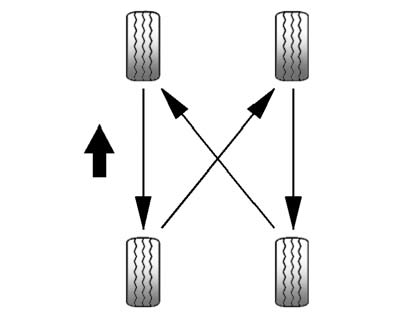Tire Rotation
Tires should be rotated every 12 000 km (7,500 mi).
See Maintenance Schedule.
Tires are rotated to achieve a uniform wear for all tires.
The first rotation is the most important.
Any time unusual wear is noticed, rotate the tires as soon as possible and check the wheel alignment. Also check for damaged tires or wheels.
See When It Is Time for New Tires and Wheel Replacement.

Use this rotation pattern when rotating the tires.
Do not include the compact spare tire in the tire rotation.
Adjust the front and rear tires to the recommended inflation pressure on the Tire and Loading Information label after the tires have been rotated. See Tire Pressure and Vehicle Load Limits.
Reset the Tire Pressure Monitor System. See Tire Pressure Monitor Operation.
Check that all wheel nuts are properly tightened. See “Wheel Nut Torque” under Capacities and Specifications.
WARNING
Rust or dirt on a wheel, or on the parts to which it is fastened, can make
wheel nuts become loose after time. The wheel could come off and cause an
accident. When changing a wheel, remove any rust or dirt from places where the
wheel attaches to the vehicle. In an emergency, a cloth or a paper towel can be
used; however, use a scraper or wire brush later to remove all rust or dirt.
Lightly coat the center of the wheel hub with wheel bearing grease after a wheel change or tire rotation to prevent corrosion or rust build-up.
Do not get grease on the flat wheel mounting surface or on the wheel nuts or bolts.
See also:
Compass Messages
CAL
This message is displayed when the compass needs to be calibrated.
See Compass.
Three dashes will be displayed if the compass needs service. See your dealer
for service. ...
Gasoline Specifications
(U.S. and Canada Only)
At a minimum, gasoline should
meet ASTM specification
D 4814 in the United States or
CAN/CGSB–3.5 or 3.511 in Canada.
Some gasolines contain an
octane-enhancing additive
called methylcyclop ...
Returning the Seat to the Sitting Position
To return the seat to the sitting position from the tumbled position:
1. Pull the seat down until it latches to the floor. The seatback cannot be raised
if the seat is not latched to the floor.
...






